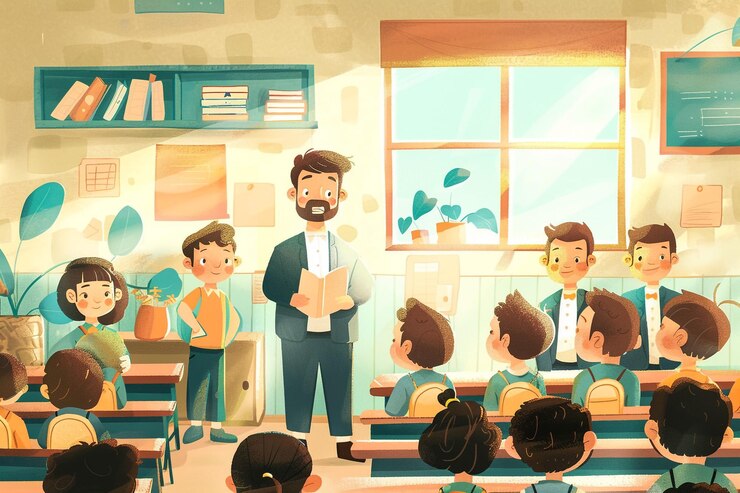A teacher fulfils multiple vital functions in nurturing the minds of upcoming generations. They offer more than just instruction—they are mentors, guides, and role models who influence students’ emotional, intellectual, and social evolution. While imparting knowledge is a teacher’s principal duty, their responsibilities extend beyond the classroom. This article explores the seven essential roles of teacher and how each contributes to students’ rounded growth.
1. The Instructor

The role of teacher as an instructor is most recognizable. Educators are accountable for delivering lessons, explaining concepts, and ensuring comprehension. This foundation supports teaching, with teachers functioning as the primary source of wisdom. The instructor focuses on transmitting the core academic material, whether in a traditional setting, online, or through experiential learning.
- Lesson Planning: Effective teachers dedicate significant time to crafting engaging, challenging lessons aligned with courses. They balance meeting standards with addressing individual needs.
- Evaluation: Teachers assess progress through tests, projects, and other tools, guiding instruction and tracking learning outcomes.
The roles of a teacher as an instructor demand them to adapt their teaching styles to meet different learning desires. Whether teaching young children or adults, teachers harness approaches to maximizing understanding.
2. The Facilitator
Beyond merely delivering information to passive students, a skilled teacher acts as a facilitator of engaged learning.
- Analytical abilities: In this paradigm-shifting role, the educator cultivates critical thought, problem-solving understanding, and independent scholarship in students. Teachers enhance analytical abilities and real-world applicability by guiding learners to find answers through inquiry, discussion, and hands-on experimentation.
- Collaboration: Teachers also facilitate collaboration, equipping students to work pleasantly in teams while communicating productively and resolving disagreements constructively. Developing these interpersonal talents serves pupils well in both academic and professional contexts.
The facilitator prioritizes student participation and involvement, recognizing that internalization occurs most thoroughly when students actively participate in the educational process.
3. The Mentor

The most impactful roles of a teacher is that of a trusted confidant and guide.
- Personal guidance: Educators often counsel learners, offering direction on academic issues and personal and social matters. Through wise advice tailored to individual strengths, limitations, and aspirations, mentors nurture self-assurance, resilience, and purposeful vision in students.
- Emotional support: In addition to specialized counsel, teachers provide emotional support during challenges involving peers, family dynamics, or pressure. A compassionate mentor can make a memorable difference in a student’s emotional wellness.
Such guidance continues as teachers consistently encourage and advice, helping learners realize their potential and remain motivated toward goals.
4. The Role Model
Educators frequently serve as role models, especially for younger pupils. The instructor’s behaviors, attitudes, and principles can leave an enduring impression on their students. Teachers who demonstrate respect, kindness, patience, and integrity establish an example that learners may carry throughout their lives.
- Character Development: A teacher’s role in character formation is crucial. By demonstrating ethical conduct and solid interpersonal abilities, teachers help students cultivate similar values. This involves fostering respect for others, a sense of accountability, and empathy.
- Leadership through Example: An instructor’s capability to lead by example is influential. When teachers showcase professionalism, dedication, and a passion for learning, they inspire their students to adopt similar attitudes toward their instruction.
The roles of teacher as a role model is essential, as learners often look up to their teachers and copy their actions. This responsibility necessitates teachers to be mindful of their behavior inside and outside the classroom.
5. The Leader and Communicator

The roles of teachers as a leader and communicator within their classrooms and schools is essential. Whether administration a group of students, directing a panel, or contributing to school-wide projects, instructors are developers who influence academic rules and practices.
- Classroom Governance: Teachers must capably conduct themselves as leaders in the classroom, establishing simple expectations, upholding order, and building a good learning environment. Adept classroom administration ensures learners concentrate on and engage in their studies.
- Educational Headship: Beyond their classrooms, teachers may participate in syllabus evolution, plan school occasions, or advocate for regulation alterations. Teachers who take up leadership roles contribute to bettering the general quality of training.
Competent administration also allows students to accept leadership roles, nurturing a sense of ownership and responsibility in their education.
6. Interacting with Others
Correspondence is a pivotal ability for teachers, both in the classroom and outside. Teachers must effectively convey knowledge to students, parents, and coworkers. This includes the conveyance of lessons and the capacity to listen and react to the necessities and worries of students and their families.
- Clear Interaction: Educators must be clear and brief, ensuring students understand instructions, ideas, and desires. This incorporates using spoken, written, and non-verbal correspondence strategies.
- Parent-Teacher Engagement: Teachers additionally play a crucial part in corresponding with parents. Through regular updates, parent-teacher meetings, or casual discussions, teachers must educate parents about their children’s advancement and any difficulties they may face.
The ability to interact with others highlights the significance of constructing solid relationships, which is facilitated by open and honest communication. This encourages the creation of a supportive learning environment for students.
7. The Lifelong Learner

Teachers constantly evolve their practice through learning. Staying updated allows them to guide students in a changing world effectively. New ideas and strategies keep lessons fresh and engaging. Continuous growth ensures students benefit from innovative teaching.
- Professional Learning: Teachers regularly participate in workshops, seminars and conferences to refine their craft. These opportunities expose them to current research and teach new techniques. Staying immersed keeps instruction relevant and prepares students for the future.
- Reflective Practice: Effective teachers thoughtfully examine each lesson’s impact. They gather input from students and peers and conduct self-analysis to strengthen weak areas. This critical self-review drives minor improvements that accumulate into transformed classrooms.
As education advances, dedicated teachers find inspiration through learning. The roles of teacher requires versatility and creative problem-solving. Commitment to lifelong learning sustains this ability and maintains high-quality guidance.
Conclusion
Teachers wear many hats—instructor, advisor, role model, and more. Each supports students’ complete growth and prepares them for life. By fulfilling responsibilities inside and outside the classroom, teachers build skills, values, and passions that serve them lifelong. Their influence deeply shapes both individuals and society. When performed with care, roles of teacher can transform lives through undulation effects that echo for generations.
























